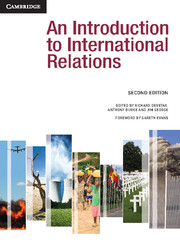Book contents
- Frontmatter
- Contents
- Tables, Figures and Boxes
- Contributors
- Preface and acknowledgements
- An Introduction to International Relations: The origins and changing agendas of a discipline
- 1 Theories of International Relations
- 2 The Traditional Agenda
- 3 The New Agenda
- 21 The United Nations
- 22 Non-State Actors: Multinational Corporations and International Non-Governmental Organisations
- 23 Religion and Secularism
- 24 Global Economic Institutions
- 25 Global Trade
- 26 Global Finance
- 27 Global Poverty, Inequality and Development
- 28 Globalisation and Its Critics
- 29 Global Terrorism
- 30 Post-Conflict State-Building
- 31 Humanitarian Intervention
- 32 Human Rights
- 33 Migration and Refugees
- 34 Global Environmental Politics
- 35 Climate Change
- Glossary of Terms
- Bibliography
- Index
- References
26 - Global Finance
from 3 - The New Agenda
- Frontmatter
- Contents
- Tables, Figures and Boxes
- Contributors
- Preface and acknowledgements
- An Introduction to International Relations: The origins and changing agendas of a discipline
- 1 Theories of International Relations
- 2 The Traditional Agenda
- 3 The New Agenda
- 21 The United Nations
- 22 Non-State Actors: Multinational Corporations and International Non-Governmental Organisations
- 23 Religion and Secularism
- 24 Global Economic Institutions
- 25 Global Trade
- 26 Global Finance
- 27 Global Poverty, Inequality and Development
- 28 Globalisation and Its Critics
- 29 Global Terrorism
- 30 Post-Conflict State-Building
- 31 Humanitarian Intervention
- 32 Human Rights
- 33 Migration and Refugees
- 34 Global Environmental Politics
- 35 Climate Change
- Glossary of Terms
- Bibliography
- Index
- References
Summary
Introduction
This chapter presents a fleeting history of key changes in global finance during the past century based around the themes of crisis, architecture and socialisation, with an emphasis on the role of US power in shaping global finance. Through these three themes we can see why global finance has become increasingly internationally institutionalised, as well as how it is having an ever-greater impact on our everyday lives. The first section of the chapter discusses global finance in the first half of the twentieth century. The second section considers the emergence of the post-World War II Bretton Woods regime. The third section outlines the rise of private capital in the 1970s. The fourth section traces the impact of the debt crisis of the 1980s. The fifth section considers discussions of global financial architecture in the 1990s. Finally, the sixth section discusses the role of surveillance and re-regulation in our contemporary global financial system. Key international regimes are listed in Box 26.1.
Who is afraid of the global financial system?
Within international relations, calls for the study of global finance were initially based on fears that market actors had gained the upper hand over states after the collapse of the Bretton Woods system of international finance (explained below). It was thought that the international political economy would be prone to frequent and severe economic crises, with advanced industrial economies forced to dismantle their welfare regimes at the behest of international financial competition. Increased power to financial markets, the logic followed, would also increase developing states’ structural economic dependence on the West as the drive for increasing profits led to a more aggressive extraction of resources and exploitation of cheap labour.
- Type
- Chapter
- Information
- An Introduction to International Relations , pp. 360 - 371Publisher: Cambridge University PressPrint publication year: 2011

